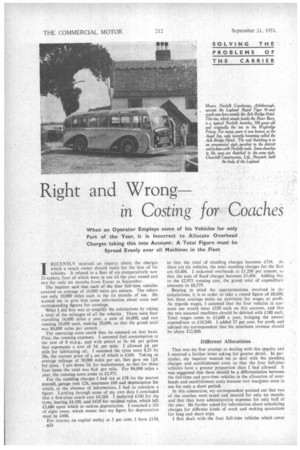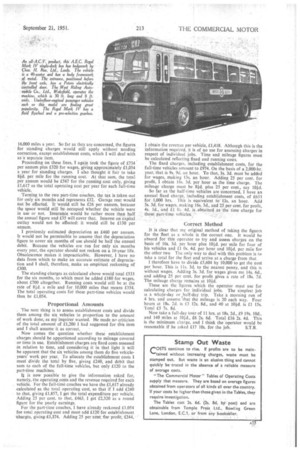Right and Wrong in Costing for Coaches
Page 58

Page 61

If you've noticed an error in this article please click here to report it so we can fix it.
When an Operator Employs some of his Vehicles for only Part of the Year, it is Incorrect to Allocate Overhead Charges taking this into Account: A Total Figure must be Spread Evenly over all Machines in the Fleet
IRECENTLY received an inquiry about the charges which a coach owner should make for the hire of his vehicles. It related to a fleet of six comparatively new 32-seaters, four of which were in use all the year round and two for only six months from Easter to September.
The inquirer said that each of the four full-time vehicles covered an average of 16,000 miles per annum. The others ran only 10,000 miles each in the six months of use. He wanted me to give him some information about costs and corresponding figures for earnings. What I did first was to simplify the calculations by taking a total of the mileages of all the vehicles. There were four travelling 16,000 miles a year, a sum of 64,000, and two running 10,000 each, making 20,000, so that the grand total was 84,000 miles per annum.
The operating costs could then be assessed on that basis. First, the running expenses. I assumed fuel consumption at the rate of 8 m.p.g., and with petrol at 3s, 4d. per gallon that represents a cost of 5d. per mile. I allowed id. per mile for lubricating oil. I assumed the tyres were 8.25 by 20s, the current price of a set of which is £160. Taking an average mileage of 30,000 miles per set, that gave me lid. for tyres. I put down 2d. for maintenance, so that for those four items the total was 8-kl. per mile. For 84,000 miles a
year, the running costs come to £2,975. , For the standing charges I had tax at £58 (to the nearest pound), garage rent £26, insurance £60 and depreciation for which, in the absence of information, I had to calculate a figure. Looking through some of my own data I concluded that a first-class coach cost £4,260. I deducted £160 for the tyres, leaving £4,100, and £420 for residual value, which left £3,680 upon which to reckon depreciation. I assumed a life of eight years, which meant that my figure for depreciation must be £460.
For interest on capital outlay at 3 per cent. I have £130, B24
so that the total of standing charges becomes £734. As there are six vehicles, the total standing charges fot the fleet are £4,404. I reckoned overheads at £1.200 per annum, so that the sum of fixed charges becomes £5,604. Adding that to the £2,975 running cost, the grand total of expenditure amounts to £8,579.
Bearing in mind the approximations involved in th.: calculations, it is in order to take a round figure of £8,600. but these castings make no provision for wages or profit. As regards wages, I assumed that the four vehicles in constant use would incur £320 each on this account, and that the two seasonal machines should be debited with £180 each. Total wages came to £1,640 a year, bringing the annual expenditure to £10,240. I added 25 per cent. for profit and advised my correspondent that his minimum revenue should be about £12,000.
Different Allocations
That was my first attempt at dealing with this inquiry and I received a further letter asking for greater detail. In particular, my inquirer wanted me to deal with the standing charges and establishment costs so that the four full-time vehicles bore a greater proportion than I had allowed. It was suggested that there should be a differentiation between the full-time and part-time vehicles in the allocation of overheads and establishment costs because two macttines were in use for only a short period.
In this connection, my correspondent pointed out that two of the coaches were taxed and insured for only six months and that they bore administrative expenses for only half of the year. He further asked for information about calculating charges for different kinds of work and making quotations for long and short trips.
I first dealt with the four full-time vehicles which cover 16,000 miles a year. So far as they are concerned, the figures for standing charges would still apply without needing correction, except establishment costs, which I will deal with as a separate item.
Proceeding on these lines, I again took the figure of £734 per annum plus £320 for wages, giving approximately £1,054 a year for standing charges. I also thought it fair to take 8-id. per mile for the running cost. At that sum, the total per annum would be £567 for the runningcost only, giving £1,617 as the total operating cost per year for each full-time vehicle.
Turning to the two part-time coaches, the tax is taken out for only six months and represents £32. Garage rent would nor be affected. It 'would, still be £26 per annum, because the space would still be. occupied whether the vehicle were in use or not. Insurance would be rather more than half the annual figure and £35 will cover that. Interest on capital . outlay would not be affected; it would still be £130 per annum.
I previously estimated depreciation as £460 per annum. It would not be permissible to assume that the depreciation figure to cover six months of use should be half the annual debit. Because the vehicles are run for only six months every year, the operator should not reckon on a 16-year life. Obsolescence makes it impracticable. However, 1 have no data from which to make an accurate estimate of depreciation and I shall, therefore, make an empirical reckoning of £300.
The standing charges as calculated above Would total £533 for the six months, to which must be added £180 for wages, about £700 altogether, Running costs would still be at the rate of 8id. a mile and -for 10,000 miles that means 1354. The total operating costs for these part-time vehicles would thus be £1,054.
Proportional Amounts
The next thing is to assess establishment costs and divide them among the six vehicles in proportion to the amount of work done, as my inquirer wanted. He -made no criticism of the total amount of £1,200 I had suggested for this item and I shall assume it as correct, Now comes the question whether these establishment charges should be apportioned according to mileage covered or time in use. Establishment charges are fixed costs assessed in relation to time, and considering it in that light it will be apparent that the six vehicles among them do five vehicleyears' work per year. To allocate the establishment costs I must divide the total by five, giving £240, and debit that sum to each of the full-time vehicles, but only £120 to the part-time machines.
It is now possible to give the information asked for, namely, the operating costs and the revenue required for each vehicle. For the full-time coaches we have the £1,617 already calculated as the total operating cost, so that if I add £240 to that, giving £1,857, I get the total expenditure per vehicle. Adding 25 per cent. to that, £463, I get £2,320 as a round figure for the yearly earnings.
For the part-time coaches, I have already reckoned £1.054 for total operating cost and must add £120 for establishment 'charges, giving41,174. Adding 25 per cent for profit; £244,
I obtain the revenue per vehicle, £1,418. Although this is the information required, it is of no use for assessing charges in respect of individual jobs_ Time and mileage figures must be calculated reflecting fixed and running costs.
The fixed charges, including establishment costs, for the full-time vehicles amount to £974. On the basis of a 2,000-hr. year, that is 9s. 9th an hour. To that, 3s. 3d. must be added for wages, making 13s. an hour. Adding 25 per cent, for profit, I obtain 16s. 3d. per hour as the time charge. The mileage charge must be 814. plus 25 per cent., say bid. -So far as the half-time vehicles are concerned, I have an annual fixed charge, including establishment costs, of £653 for .1,000 hrs. . This is equivalent to 13s. an hour. Add 3s. 3d. for wages, making 16s. 3d., and 25 per cent, for profit, 4s. Id., and It 0.i. 4d.. is: obtained as • the time -charge for these part-time. vehicles. A
Correct Method
It is clear that my original method of taking the figures for the fleet as a whole is the correct one. It would be absurd for this operator to try and assess charges on the basis of 16s. 3d. per hour plus 10-id. per mile for four of his vehicles and £1 Os. 4d. per hour and lold, per mile for the other two The only way to deal with this problem is to take a total for the fleet and arrive at a charge from that.
I therefore have to divide £5,604 by 10,000 to get the cost per hour. This is 1 Is. 3d. to the nearest penny, and this is without wages. Adding 3s. 3d. for wages gives me 14s. 6d., and adding 25 per cent, for profit gives a rate of 18s. 2d. The mileage charge remains at 101-d.
These are the figures which the operator must use for calculating charges for individual jobs. The simplest job is a whole-day or .half-day trip. Take a morning run of 4 hrs. and assume that the mileage is 20 each way. Four hours at 18s. 2d1 is £3 12s. 8d., and 40 at 100. is £1 15s. Total £5 7s. 8d.
Now take a full-day tour of 11 hrs. at 18s. 2d., £9 19s. 10d., and 140 miles at bid., £6 2s. 6d. Total £16 2s. 4c1. This is the minimum charge, and I think the operator would he
reasonable if he asked £17 10s, for the job. S.T.R.




























































































